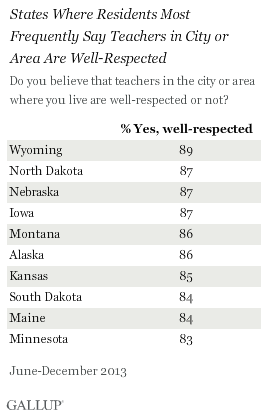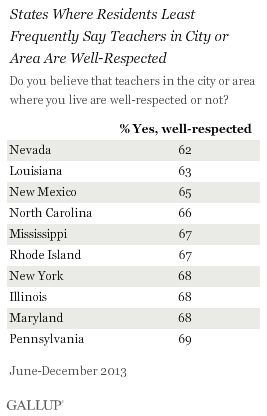This article is part of a weeklong series analyzing how education leaders, students, and teachers evaluate education in America. The series will feature Americans' opinions on topics such as the Common Core, a uniform set of academic skills and competencies in U.S. schools; the quality of public K-12 education; the level of respect for U.S. teachers; and the viability of online higher education.
WASHINGTON, D.C. -- Residents living in several states in the West and Midwest lead the nation in saying teachers in their communities are well-respected. Nevadans and Louisianans are among the least likely to say this about their local teachers -- slightly more than six in 10 residents in each state say their teachers are well-respected.


The results are based on a special 50-state Gallup poll conducted June-December 2013, including interviews with at least 600 residents in every state, allowing Gallup to report Americans' perceptions of public education at the state level for the first time. The complete list for all 50 states is on page 2.
Eight of the states where residents are most likely to say teachers are well-respected also topped the lists of states in which residents say public school quality is excellent or good and students are well-prepared for workplace success. North Dakota, South Dakota, Iowa, Nebraska, Minnesota, Wyoming, Montana, and Kansas have strong economies with some of the lowest unemployment rates nationwide, which may help fuel a sense of optimism in local communities about their schools and teachers. Wyoming, Alaska, and Maine are near the top of the list of states in terms of per pupil expenditures for students in public elementary and secondary education, which may be reflected in the high respect rankings.
Five of the states where residents are least likely to say teachers are well-respected -- Nevada, Louisiana, New Mexico, Mississippi, and Illinois -- also appear among the list of states where residents least frequently rate the quality of education as excellent or good. These states face a more challenging economic landscape with unemployment rates exceeding 9% in Nevada and Illinois and poverty levels of 20% or higher in New Mexico, Louisiana, and Mississippi.
Bottom Line
Although a clear majority of residents from each state in the union perceive that teachers in their local areas are well-respected, Gallup's latest research in the State of America's Schools report indicates that, overall, teachers don't feel they get much respect at work. In fact, according to the report teachers are last among occupational groups Gallup regularly tracks nationally in terms of their likelihood to say their opinions seem to count at work -- an important element in measuring workplace engagement. When teachers' engagement levels drop, as tends to be the case in their first few years on the job, it can jeopardize their students' drive to achieve. It also helps to explain why between 40% and 50% of teachers leave the profession within their first five years on the job.
Still, teachers are more likely than those in most other job types to say they have the opportunity to do what they do best every day at work, another vital factor in creating an engaged workforce. This finding reinforces the notion that good teachers view their role as more than just a job or career -- they see it as a calling. School leaders can build on this high level of dedication and commitment by ensuring teachers have a voice in school-level decisions that affect them and their classrooms. Schools can also do more to help create a culture of education in their states and communities that gives teaching a stronger standing. This will attract the most talented candidates to the profession and help ensure teachers receive the respect they deserve from residents in every state.
Survey Methods
Results for this Gallup poll are based on telephone interviews conducted June-December 2013, with a random sample of approximately 600 adults per state, aged 18 and older, living in all 50 U.S. states.
For results based on the total sample of adults per state, the margin of sampling error is ±5 percentage points at the 95% confidence level.
Interviews are conducted with respondents on landline telephones and cellular phones, with interviews conducted in Spanish for respondents who are primarily Spanish-speaking. Each sample of national adults includes minimum quotas of cellphone respondents and landline respondents based on cellphone and landline use in the respective state. Landline and cellular telephone numbers are selected using random-digit-dial methods. Landline respondents are chosen at random within each household on the basis of which member had the most recent birthday.
Samples are weighted to correct for unequal selection probability, nonresponse, and double coverage of landline and cell users in the two sampling frames. They are also weighted to match the state demographics of gender, age, race, Hispanic ethnicity, education, region, population density, and phone status (cellphone only/landline only/both, and cellphone mostly). Demographic weighting targets are based on the most recent Current Population Survey figures for the aged 18 and older U.S. population. Phone status targets are based on the most recent National Health Interview Survey. Population density targets are based on the most recent U.S. census. All reported margins of sampling error include the computed design effects for weighting.
In addition to sampling error, question wording and practical difficulties in conducting surveys can introduce error or bias into the findings of public opinion polls.
For more details on Gallup's polling methodology, visit www.gallup.com.

